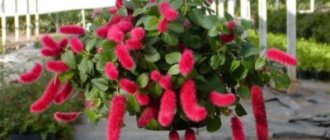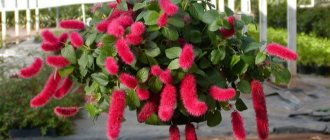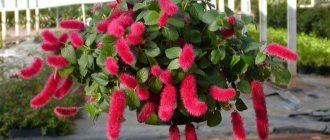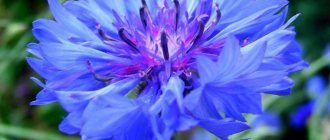Akalifa stands out among other ornamental plants with its original leaf color and unusual inflorescences, reminiscent of a fox tail. It is for this feature that it received its second name - foxtail. The shape of the leaves is slightly reminiscent of nettle leaves, so the plant was named Akalitha (translated from Greek - nettle).
Home care
An experienced florist is quite capable of creating conditions so that akalifa retains the decorativeness and richness of the leaves and grows normally, constantly forming ovaries and delighting with its unusual flower-tails.
Just be sure to work with the plant with gloves, remembering that it is poisonous. And make sure that neither children nor animals have access to the bush.
Location and lighting
The foxtail needs long daylight hours to function properly. Therefore, in winter, place the plant on a south-facing windowsill and add a lamp. In summer, shade slightly so that there is light, but without direct sunlight. When it’s warm, you can put the pot on the balcony or even in the yard. But make sure that it is not windy and without drafts.
If there is not enough light for the Polynesian friend, the stems will stretch upward unattractively, and the leaves will lose their variegated decorativeness, becoming pale. You can safely place the akalifa on the kitchen window - smells and steam will not harm it.
Temperature
A tropical plant, of course, prefers warmth. In the room where the foxtail is kept, the temperature should not drop to +16°C. In summer, it is advisable to maintain 22-25 degrees; in winter, you can slightly reduce the temperature to +18°C. But if the apartment is warmer, there is no need to specifically lower the temperature. Make sure that the window sill is not too cold during the cold season and does not cool the soil in the pot.
Watering
Pacific nettle is a well-known water feeder. The higher the temperature in the room, the more often it is necessary to add life-giving moisture. In summer this is done approximately once every two days, in winter - once a week. The water should be purified, acidified, settled and slightly heated (up to 20 degrees). If you overfill and water appears in the pan, do not leave it, but immediately drain the excess.
In winter, the amount of watering should be reduced. But if the house is very warm, make sure that the soil always remains moist. A decrease in temperature and infrequent watering will cause the akalifa to go into hibernation.
Air humidity
Create a humid atmosphere around the foxtail. To do this, spray the air around the plant as often as possible. You can place the pot in a tray filled with damp peat. To maintain high air humidity, you can place a jar of water nearby. If possible, use a humidifier.
The soil
For a representative of the Euphorbiaceae family, select a soil mixture that is light and well-permeable to moisture and air. You will need the following components:
- 40% turf land;
- 15% leaf;
- 20% greenhouse;
- 5% sand;
- 5% acidic high peat;
- 15% leaf soil.
To avoid fussing with ingredients, you can purchase a ready-made rose mixture at a flower shop. Just be sure to line the bottom of the pot with drainage, and then you can add soil.
Feeding and fertilizers
In winter, the bush does not need feeding. And from March to October, fertilizers will need to be applied every two weeks. Alternate mineral and organic fertilizers. This is important, since at this time Akalifa spends a lot of energy developing buds and flowering.
Transfer
Foxtail should be replanted in the spring. Just don't choose a pot that's too big. The roots of the Polynesian green friend prefers tight spaces. You don’t have to replant the whole bush at all, but simply replace the top layer of soil with fresh soil, always with a slightly acidic reaction.
While the plant is young and growing intensively, change containers every year, and in adulthood it will be enough to move to a new pot every 3-4 years. When transshipping, shorten the sprouts by half.
Before transplanting, be sure to disinfect the pot. Pour drainage into it 2 cm - expanded clay or gravel. Pull out the plant along with a lump of earth, remove damaged particles. Place the new pot in the center and add fresh soil.
Be sure to wear gloves, not forgetting about the toxicity of the ward.
Having noticed that the acalyph has degenerated and lost its decorative effect, cuttings should be taken from it, and there is no point in replanting the plant itself.
Trimming
This beauty must be pruned ruthlessly in February in order to rejuvenate and preserve the bush. Otherwise, in two years it will turn into an unattractive plant without specific characteristics. Leave the stump at 20-30 cm. To make it produce young shoots faster, cover it with a glass jar or stretch polyethylene over it. To stimulate growth, treat it with Zircon solution. Every day, remove the jar, spray and ventilate the bush, or rather, what’s left of it.
While Akalifa is young, constantly pinch the top of the shoots for better branching and development of lateral buds.
Transplanting a plant
Young Akalifas are replanted every year, while adult specimens are replanted every 3 or 4 years; if Akalifa has lost its decorative effect, then it is necessary to renew it by rooting cuttings.
The soil mixture for growing Foxtail should be light and permeable to air and water. Composition: turf, leaf soil, sand, high peat, taken in equal proportions. But in different sources of substrate information, the ratio of parts fluctuates in these ranges: 4 parts turf soil, 2 parts greenhouse soil, 1 part leaf soil, and acidic high peat or 0.5 sand and one part each leaf soil and sand.
Bloom
Foxtail usually blooms for six months. Spikes of flowers of scarlet, burgundy and other shades of red fall down. Occasionally there are pink, white and even green specimens.
They form especially intensively in summer. Remove faded, dried ovaries to preserve the plant’s strength for new flowers.
In the wild, Akalifa can bloom all year round. If you create conditions that are as close to tropical as possible, then your ward will extend the flowering period to the maximum, releasing as many catkins as possible. Every year the inflorescences will become longer and longer.
Reproduction
Usually, foxtail is propagated in two ways - by sowing seeds or cutting apical cuttings. Fiddling with seedlings is recommended only for experienced gardeners, while beginners or people with limited free time are better off using the second method. And bushes grown from seeds look worse and grow more slowly.
Propagation by seeds
Sow seeds in March. Before sowing, soak for 24 hours in Zircon solution. Deepen the seed 5-6 mm into the sand-peat mixture. Spray with water and cover with film. Place in the light so that the container is not exposed to direct sunlight, and cover with plastic wrap. Be sure to remove the film every day, moisturizing and ventilating the plantings.
The room should be moderately warm: +20-22°C. If possible, arrange lower heating - this way the shoots will appear earlier and more efficiently. If the temperature drops regularly at night, your crops may die.
As soon as the seedlings reach 2-3 cm, plant them in separate pots or plastic glasses. Take soil as for an adult plant. And handle the roots very carefully so as not to damage them.
Propagation by cuttings
You can root cuttings throughout the year, but it is best to do this in the spring. To do this, cut off the apical shoots that have become lignified to a length of 8-10 cm. Don’t bother with young or side shoots - you’ll waste your time and energy. Treat the cut areas with a root growth stimulator and break off the lower leaves.
The cuttings can be placed in water to allow roots to sprout, or they can be immediately planted in a turf-sand mixture. With constantly moist soil, sufficient light and an air temperature within +20-25 degrees, there will be no reason for Akalifa not to take root. Cover the cuttings with film, ventilating and moistening the sprouts every day.
After rooting, plant them in separate pots. Gradually get used to bright sunlight. After a month and a half, be sure to pin it, removing the upper buds.
Pruning akalifa
This plant quickly loses the beauty and compactness of its bushes, actively develops and often “falls apart”. Therefore, it is better to trim the akalifa regularly, forming or maintaining beautiful silhouettes. The best time for pruning is spring, before replanting. Shorten the longest shoots and pinch out the tops of stray branches.
In addition to the actual formative pruning, you will need acalife and timely removal of fading inflorescences. The thing is that Akalifa's pedicels are already sticky, and fading flowers become a kind of magnet for rot and dust. You also need to promptly remove dry or wilted leaves from the bushes.
Carefully monitor your plants: acalyphs in indoor culture, especially if they have been restrained in growth, are prone to degeneration, overgrowth, and at the first signs of oppression it is necessary to carry out radical rejuvenation. Branches up to 25 cm long are left on the bushes, weak and damaged ones are cut out, and the tops of the shoots are used for cuttings. Recovery will require patience: the mother plant will initially show no signs of growth for a long time, but then will quickly and actively begin to take root.
Frequency of replanting : only as needed, after the soil is completely filled with roots. Transplant time : spring, at the very beginning of active growth. Substrate : light, air- and water-permeable (an earth mixture of equal parts of high-moor peat, leaf soil, turf soil and sand is best suited).
Diseases and pests
Don't worry about akalifa attracting pests. This happens extremely rarely.
But if you notice yellow spots on the leaves and white cobwebs, it means a spider mite has attacked. Spray the bush with tobacco infusion. Animal shampoo, which contains components that fight ticks, will also help.
If you see whitefly larvae on the bottom of the leaves, treat them with insecticides.
If the leaves curl into tubes, it means that aphids have entered the battle. Remove the pests and spray with a poison that includes permethrin. You can also use tar soap.
The appearance of brown or powdery spots on the leaves signals the spread of the fungus. Treat foxtail with fungicide twice, 10 days apart.
Care errors
Keep a close eye on Asian nettles. If you notice negative changes in appearance, it means you are not caring for the plant correctly.
Yellow and crumbling leaves indicate a lack of light and moisture. Add a phytolamp and spray the bush more often.
Withering, crumbling foliage indicates that the temperature is too low.
Pale elongated leaves are observed when acalife does not get enough light. Move the pot to a south window.
Slow growth and pale leaves indicate that it is time for fertilizers that contain nitrogen.
Dark spots on the leaves appear from drafts or hypothermia.
Medicinal properties
Akalifa contains specific alkaloids and glycosides. They are used to produce drugs from:
- bronchial asthma;
- bronchitis;
- pneumonia.
In Malaysia, this plant is used to brew tea. A tonic is prepared from the roots and leaves, which normalizes intestinal function.
Fox tail is widely used in homeopathy . However, the dosage of this component should be minimal, as it is poisonous.
The benefit of the plant also lies in saturating the air with phytoncides. They destroy pathogenic bacteria.
Akalifa is a beautiful and unusual plant. It requires proper air humidity and a warm climate. If you follow simple rules, this poisonous plant will be completely safe.
Kinds
The Akalifa genus has more than 450 species, varieties and hybrids. Not all of them are grown at home. Most often you can find representatives of one of two large groups:
Akalifa bristle-haired
A bush with lush greenery grows up to 50 cm with ovoid leaves of a bright green color. It can bloom all year round with large bright red flowing “tails”. If the inflorescences are white, it is the Alba variety. Prized for its unusual flowers.
Vilkez's foxtail
The evergreen shrub is grown primarily for its bronze-green leaves flecked with coppery red and edged with pink. But the pale pink flowers, collected in inflorescences, are the most ordinary - no more than 10 cm in length. Blooms throughout June-August.
3.Varieties:
3.1.Meadow foxtail - Alopecurus pratensis
A tall perennial herbaceous plant, the stems of which can reach a height of more than a meter. As the meadow foxtail ages, it forms attractive, fluffy, large tussocks. The leaves are narrow, linear, straight or slightly curved in an arc. During the flowering period, the plant develops thin, erect, geniculate flower stems with alternately arranged small leaves. The stems are covered with a bluish waxy coating. At the tops of the stems there are inflorescences - a spike with numerous green flowers.
3.2.Foxtail - Alopecurus geniculatus
Herbaceous perennials with long, linear, narrow, entire, sessile leaves of light green color. On the flower geniculate stems, the leaves are arranged alternately. During the flowering period, spikelets form at the tops of the stems. The plants reach a height of 60 cm.
3.3. Mousetail foxtail - Alopecurus myosuroides
attractive herbaceous annual plants up to 8 cm high with numerous green, linear leaves up to 15 cm long. The plant acquires its main attractiveness during the flowering period, when it forms erect shoots, at the tops of which there are green, long, slightly curved spikelets, reminiscent of ponytails in appearance mice. The long flowering period begins in May and can last throughout the summer months.
3.4. Reed or swollen foxtail - Alopecurus arundinaceus
The leaves are green, sessile, arranged alternately on the shoots, forming a fluffy tussock at the base of the plant. The peduncles are vertical, thin, and have several “knees”. At the tops of the peduncles there are small green spikelets with flowers that become beige or light brown when ripe. Flowering begins in mid-spring and ends in July.
Folk signs
Akalifa is a symbol of balance and helps to find harmony. It will warm those who are often cold. Spendthrifts will be taught to save. The letter eater will make you appreciate your spiritual qualities. Any maximalist will be led to the “golden mean”.
It will affect not only character, but also the harmonization of the work of all organs and systems within the body. Especially indicated for heart patients.
Men in a house where foxtail grows will become steadfast and reliable, and women will become soft and loving. There will be no place for laziness, despondency, or pessimism in the house.
Now you know almost all the secrets of the miracle flower. By devoting a little time and effort to the plant, you will get a simply fabulous result in the form of living “fox tails”.
Possible problems during cultivation
Improper care leads to loss of decorativeness and reduced flowering. All the mistakes that the grower made are reflected in the appearance of the plant:
- In poor lighting, the stems will become very elongated, the leaves will become smaller and turn pale.
- Yellowed falling leaves with dry tips will indicate that the room has dry air and insufficient watering.
- Slow growth and pale foliage indicates a lack of nitrogen fertilizers.
- Drafts and cold indoor air coupled with frequent watering can cause dark spots to appear on the leaves and a fungal infection.
Akalifa is rarely attacked by pests. But errors in care can cause infection with spider mites, aphids, and whiteflies.











